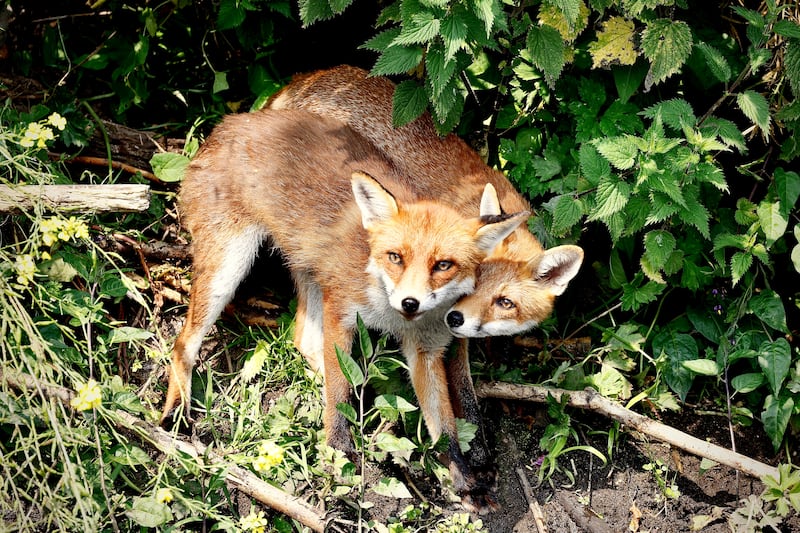“Most birdwatching is done with your ears,” says Declan Tarpey. “You hear them before you see them.”
Rathfarnham, Dublin, is coated in sunshine and as he walks along the river Dodder, Tarpey’s ears are sharp. He is one of the local birders for whom this stretch, running from Dodder Park towards Milltown, is popular for its easy access and its proximity to the river’s main attraction.
“The kingfisher is what knits the whole thing together,” he says. “If he was here for the last week, and we’d been posting up photographs, then everyone else would be here as well. The colour, the rarity. It’s our most exotic bird.”
Great patience is needed to see the kingfisher. Bright-blue and cyan, it moves like a dart along the water. Its long, pointed beak accounts for a third of its height, allowing it to stay relatively silent while it flies at 40km per hour – its mechanics inspired the design of the Japanese bullet train.

Summertime might seem like the perfect season for birdwatching, but it is the winter that draws large crowds to the Dodder from different parts of the country. Kingfishers need to eat more in colder weather, and the reduced foliage uncovers plenty of hiding spots. That is not to say the practice becomes easy.
“Last winter, I went into a place down there,” Tarpey says, pointing downstream away from the footpath. “I was there at about six in the morning before anybody was here, just for sunrise.
“I wanted to get the light coming in a particular way. I was sitting and I had a branch ready. He came for about 10 seconds, and I just managed to get two shots – and he was gone. I was there an hour, an hour and a half. Ten seconds and you either miss it or you don’t.”
Tarpey moved to Dublin from Mayo 25 years ago, though he has held an interest in birdwatching for longer.
Jimmy Cahill, who has lived in Crumlin most of his life, is a more recent convert. He fished on the Dodder as a child but only took to this hobby six years ago.
[ White-tailed sea eagles win over farmers thanks to successful Irish returnOpens in new window ]

“The dippers nest in the weir. The grey wagtail is a lovely, colourful bird. And the hens, and the cormorants and the otters – this place is just a mecca. People come up from everywhere,” says Cahill.
As he describes his love for the river, he produces a slingshot and a Tupperware container full of dog treats. He fires the biscuits off into the opposite bank, and a pair of foxes emerge from the bushes. “It’s like Jurassic Park, isn’t it?” he adds.
Both men ready their cameras. They have christened the mother fox Goalie. In time, she is likely to push the other animal away, so for now, her cub remains nameless. Differentiating the two at all from this distance requires an eye for detail – the camerawork can help with that.
“Some people wouldn’t come out with a camera at all,” Tarpey says. “And they could feel like they’re a superior version of a birdwatcher. They might see the photographers as a tourist just going around clicking.
“But really, from my perspective, the two hobbies are very complementary. You see detail when you’re taking photographs, and you’re looking for extra detail that you wouldn’t be looking for if you just wanted to spot the birds.”
Birders share information on rare sightings around the country. There is a local network on the Dodder, but the community extends far beyond that. A yellow-crowned night heron arrived in Mayo a couple of months ago – the first of its kind ever spotted in Ireland. Within 24 hours, more than 50 birdwatchers had descended on the county, Tarpey being one of them.
“I saw one in Costa Rica one time on a birdwatching trip and that was the only time I ever saw one,” he says. “To think that he was back in my own county in Mayo. Myself and another fella drove down specially to see him and he was exactly where people told us he was in Belcarra, by a river there.
“What people feel happened is there was a storm and he wasn’t strong enough to weather it, and that he was blown over into Europe from America. They think from Florida. There was talk about would they bring him back to Florida because he has no mates here.”
Though the heron was an anomaly, there is scope for more exotic birds to reside in Ireland as the climate changes. In the quarter of a century that Tarpey has been coming to the Dodder, not a lot has altered outside of a recent clean-up to keep the river in order.
“Maybe the little egret wasn’t here at the beginning – the white egret,” he says. “They only came to Ireland about 40 years ago anyway. They came to Cork first and with global warming, they’ve come up a bit farther north.
“We’d probably gain more [from climate change]. Birds have come up that would’ve been too cold. In the winter, we get birds coming from the north that is too cold for them. We had a great winter this year.”
Ireland’s gain is another country’s loss. Sweden experienced its coldest weather in decades at the start of January this year, meaning there was a spillover of waxwings that migrated in search of food.
“There wasn’t enough berries for them,” Tarpey says. “They were coming down here, then eating the rowan berries. We were all out at rowan trees looking for them in housing estates and industrial estates. All sorts of places that you wouldn’t expect to find beauty.”
Other factors are having a negative impact on Ireland’s bird population. Recently, Tarpey followed a lead to Newcastle in Wicklow in the early morning before his workday began. It brought him to a cuckoo, which is slowly becoming a rarer sight on account of “vegetation and too much ploughing of the fields”.
A psychotherapist by trade, Tarpey could be waiting four hours on certain birding trips, barely moving a muscle, to get a chance at capturing something. “There’s a lovely thrill out of getting a decent shot then,” he says. “No more than in any sport I suppose really. If you’re playing golf and you get a hole in one … you’re always looking for your personal best.”
The point, though, is in absorbing the activity itself.
“An odd time, [I’d look back],” he says. “Something would come up on your phone. But it’s a bit like the windscreen in your car. You have the mirror for looking back but the bigger thing is what’s in front of you. I might look back at some of the photographs, but I’d be more forward looking at what’s in front of me.”
- Sign up for push alerts and have the best news, analysis and comment delivered directly to your phone
- Join The Irish Times on WhatsApp and stay up to date
- Listen to our Inside Politics podcast for the best political chat and analysis


















